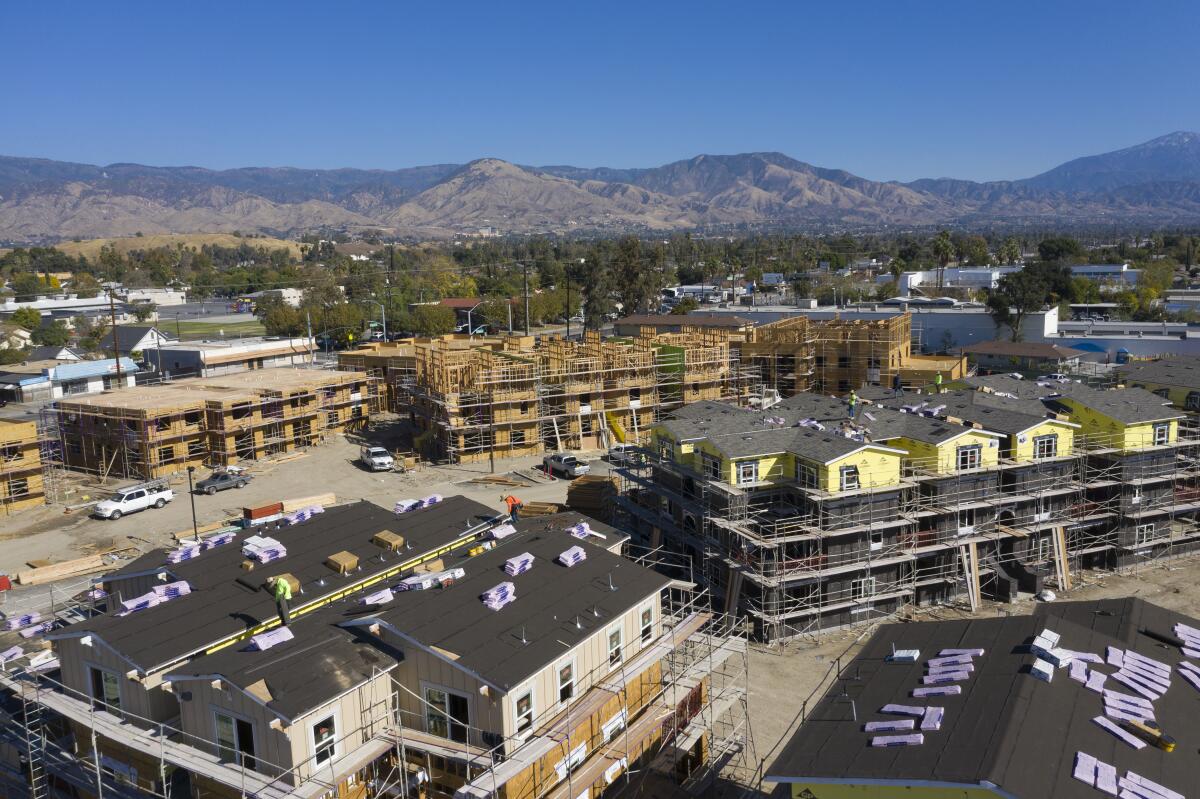Editorial: Why are Newsom, lawmakers letting a labor standoff block important housing bills?

California has a glaringly obvious housing shortage that is exacerbating poverty and homelessness and driving up rents and home prices. Yet for the last two years, a political standoff between labor unions, developers and lawmakers in Sacramento has stalled too many good bills that would make it easier to build homes, including affordable ones.
The State Building and Construction Trades Council, which represents 450,000 plumbers, roofers, pipe fitters and other skilled laborers, has opposed bills to streamline housing approvals or loosen local zoning regulations unless developers guaranteed that at least one-third of construction workers on the projects would be graduates of apprenticeship programs.
Most of these programs are union-run, and graduates typically get better pay and benefits than nonunion laborers. Robbie Hunter, the president of the Trades Council, has argued the state cannot address poverty and housing affordability by promoting a race to the bottom on construction wages.
Developers counter that the “skilled and trained workforce” requirement would add yet another mandate that would make construction even more pricey in a state that is already one of the most expensive places to build in the country. It costs, on average, half a million dollars to build one unit of affordable housing. Developers also warn that the mandate could slow construction in areas short of union labor. The effect would be less housing and higher prices.
Here’s why this stalemate has persisted: Both sides are right. More affordable housing is one of the state’s most pressing needs, but so is an increase in the supply of good jobs.
California should be encouraging the creation of blue-collar jobs with good pay and benefits. Residential construction used to be a solid middle-class career, but now the work can pay near-poverty wages. At the same time, California has the nation’s highest poverty rate when housing and other living expenses are factored in. Rising rents and skyrocketing home prices are a growing threat to the state, widening income equality and eroding economic mobility.
The competing demands from developers and the Trades Council have a common goal: making California a more livable, affordable state. It’s long past time for Gov. Gavin Newsom, Assembly Speaker Anthony Rendon and Senate President Pro Tem Toni Atkins to strike a compromise that gets more skilled construction workers building housing while ensuring that higher costs or a shortage of laborers don’t end up slowing development.
For months, legislative leaders have said they’re on the precipice of a deal. But it hasn’t materialized, and important housing bills have been sidelined as a result. That includes Senate Bill 679, which would create a Los Angeles County agency to build and preserve affordable housing. It would be legislative malpractice to sacrifice a game-changing bill to a political standoff.
Lawmakers have been quick to blame the Trades Council for killing reasonable housing bills by refusing to compromise. But union leaders are doing what advocates do. They fight for their agenda, and, yes, sometimes they play hardball politics to get what they want. But lawmakers cast the votes, not the Trades Council. And if Newsom and legislators are frustrated with the council’s unwillingness to compromise, then they should develop a reasonable policy without the union and pass it.
To address the housing shortage, California needs to add between 1.8 million and 3.5 million homes by 2025, depending on who’s calculating the need. Currently, the state is falling far short of even the low-end estimate. The shortage is especially acute for lower-income Californians; the state needs 1.2 million homes by 2030 that are affordable to households earning less than the median income.
Yet the state and its many local governments make it extraordinarily difficult and expensive to build more homes. Labor is just one input in the cost of home building. Local zoning in too many cities severely restricts sites for denser housing, including apartments and town homes. Regulatory hurdles and environmental studies increase the time and money required to get projects approved. That’s why state housing legislation is essential to unwind the red tape that is choking housing production.
Even if California communities were to rapidly ramp up housing construction, the state doesn’t have enough construction workers to do the work. Developers consistently cite a shortage of laborers as a top concern.
Laborers left the industry during the last recession and haven’t returned. There are good reasons why: When adjusted for inflation, wages for construction have risen only 3.4% since 2006, according to a 2020 Terner Center analysis of housing construction costs. And residential construction, which often uses nonunion labor, is grueling, dangerous work that just doesn’t pay like it used to. That’s why state policies should be encouraging, supporting and, in some cases, requiring training and higher pay for construction workers.
There’s got to be room for a compromise. Newsom and legislative leaders can’t lose another year to a political stalemate. California needs a lot more housing and a lot more construction workers to build it.
More to Read
A cure for the common opinion
Get thought-provoking perspectives with our weekly newsletter.
You may occasionally receive promotional content from the Los Angeles Times.










